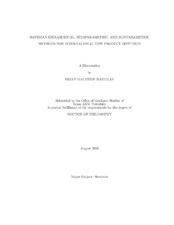| dc.contributor.advisor | Mallick, Bani K. | |
| dc.creator | Hartman, Brian Matthew | |
| dc.date.accessioned | 2011-10-21T22:02:56Z | |
| dc.date.accessioned | 2011-10-22T07:09:43Z | |
| dc.date.available | 2011-10-21T22:02:56Z | |
| dc.date.available | 2011-10-22T07:09:43Z | |
| dc.date.created | 2010-08 | |
| dc.date.issued | 2011-10-21 | |
| dc.date.submitted | August 2010 | |
| dc.identifier.uri | https://hdl.handle.net/1969.1/ETD-TAMU-2010-08-8294 | |
| dc.description.abstract | Global marketing managers are keenly interested in being able to predict the sales
of their new products. Understanding how a product is adopted over time allows
the managers to optimally allocate their resources. With the world becoming ever
more global, there are strong and complex interactions between the countries in the
world. My work explores how to describe the relationship between those countries and
determines the best way to leverage that information to improve the sales predictions.
In Chapter II, I describe how diffusion speed has changed over time. The most
recent major study on this topic, by Christophe Van den Bulte, investigated new
product di ffusions in the United States. Van den Bulte notes that a similar study
is needed in the international context, especially in developing countries. Additionally,
his model contains the implicit assumption that the diffusion speed parameter
is constant throughout the life of a product. I model the time component as a nonparametric
function, allowing the speed parameter the
flexibility to change over time.
I find that early in the product's life, the speed parameter is higher than expected.
Additionally, as the Internet has grown in popularity, the speed parameter has increased.
In Chapter III, I examine whether the interactions can be described through
a reference hierarchy in addition to the cross-country word-of-mouth eff ects already
in the literature. I also expand the word-of-mouth e ffect by relating the magnitude
of the e ffect to the distance between the two countries. The current literature only applies that e ffect equally to the n closest countries (forming a neighbor set). This
also leads to an analysis of how to best measure the distance between two countries. I
compare four possible distance measures: distance between the population centroids,
trade
ow, tourism
ow, and cultural similarity. Including the reference hierarchy
improves the predictions by 30 percent over the current best model.
Finally, in Chapter IV, I look more closely at the Bass Diffusion Model. It is
prominently used in the marketing literature and is the base of my analysis in Chapter
III. All of the current formulations include the implicit assumption that all the
regression parameters are equal for each country. One dollar increase in GDP should
have more of an eff ect in a poor country than in a rich country. A Dirichlet process
prior enables me to cluster the countries by their regression coefficients. Incorporating
the distance measures can improve the predictions by 35 percent in some cases. | en |
| dc.format.mimetype | application/pdf | |
| dc.language.iso | en_US | |
| dc.subject | Bayesian Methods | en |
| dc.subject | Nonparametrics | en |
| dc.subject | International New Product Diffusion | en |
| dc.subject | Bayesian Adaptive Regression Splines | en |
| dc.subject | Hierarchical Models | en |
| dc.title | Bayesian Hierarchical, Semiparametric, and Nonparametric Methods for International New Product Di ffusion | en |
| dc.type | Thesis | en |
| thesis.degree.department | Statistics | en |
| thesis.degree.discipline | Statistics | en |
| thesis.degree.grantor | Texas A&M University | en |
| thesis.degree.name | Doctor of Philosophy | en |
| thesis.degree.level | Doctoral | en |
| dc.contributor.committeeMember | Dahl, David B. | |
| dc.contributor.committeeMember | Gresham, Larry G. | |
| dc.contributor.committeeMember | Hart, Jeffrey D. | |
| dc.contributor.committeeMember | Talukdar, Debabrata | |
| dc.type.genre | thesis | en |
| dc.type.material | text | en |


